Comfort and connection: Asian chefs and celebrities share how food can draw us closer and divide us
Updated May 27 at 4:19 p.m.Originally published May 4, 2021
My moments of joy are around the dining table, starting with rice, whose aroma is my favorite in the world: the signal that dinner will soon be ready.
In the Asian American Pacific Islander community, food is how we show love. It’s how we communicate, how we cope and find comfort. Instead of hugs, my family piles more into your bowl.
“Food brings us all together,” said Martin Yan, who became the first Asian American to have a cooking show in 1978. “That’s the reason why in Asia, particularly China … we sit at a round table and talk to each other, face to face, in front of food.”
And like our food, the Asian American Pacific Islander (AAPI) community is diverse. The places we come from encompass more than 50 countries and territories, each with numerous ethnicities. Asian Americans make up almost 6 percent of the U.S. population and are the fastest-growing ethnic group, according to Pew Research, increasing by 81 percent between 2000 and 2019, from roughly 10.5 to 18.9 million.
To honor the community, Congress in 1978 designated May as Asian American and Pacific Islander Heritage Month, according to the U.S. Census, “to coincide with two important milestones in Asian Pacific American history”: the arrival of the first Japanese immigrants to the United States on May 7, 1843, and contributions of Chinese workers to the Transcontinental Railroad, completed May 10, 1869.
Our diversity is lovingly displayed in our dishes. When I first dated my future husband, we bonded over cooking, fusing our mothers’ recipes for the meatball entree lion’s head (shīzitóu or 獅子頭). This was the first of many compromises we made after he asked which of our mothers cooked better. We both may be Chinese, but he and his family hail from Hong Kong, while I was born in Memphis to parents from Hunan, China, and Taipei, Taiwan. His palate is a little sweeter, mine a little spicier. His question could have easily led to our first fight, if we couldn’t agree that our moms’ cooking styles were special in their own ways.
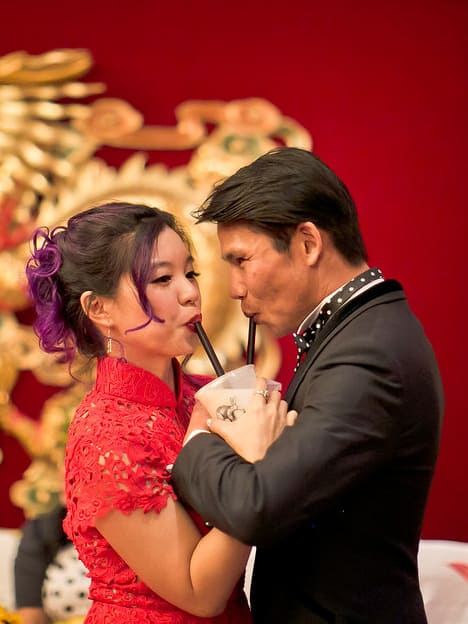
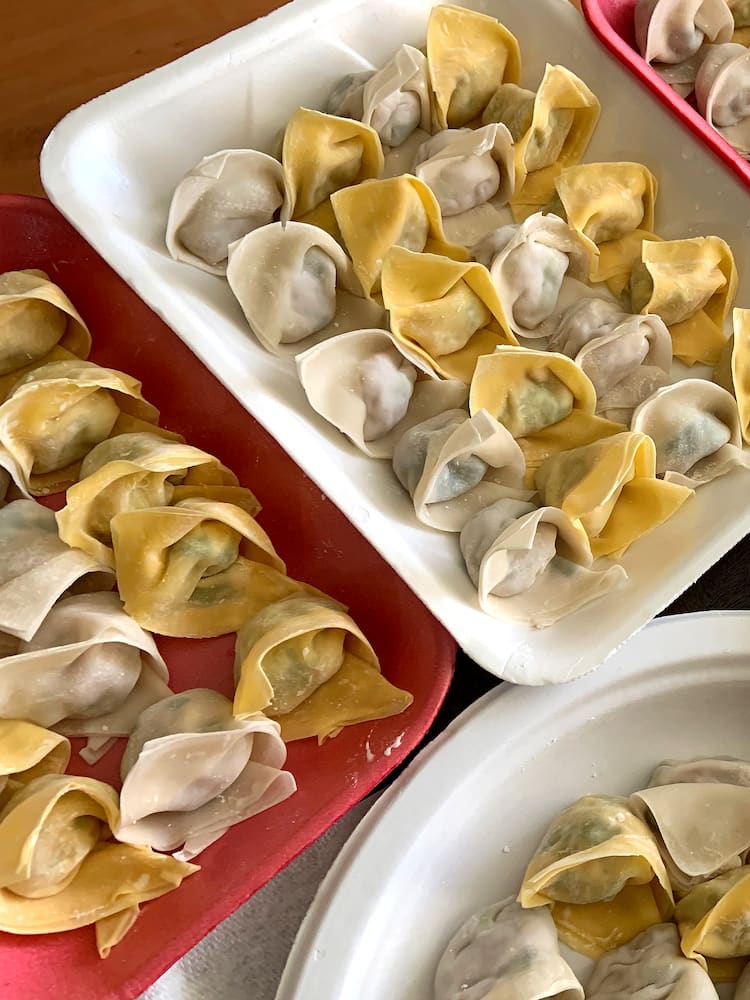
LEFT: Writer Marian Liu toasted with boba at her wedding. (Orange Turtle Photography) RIGHT: Liu has been making wontons — and dumplings — on a regular basis during the pandemic. She learned how to make and fold them from her mother. (Marian Liu/The Washington Post)
Food has also been a source of my community’s pride and pain, how many of us introduced others to our culture and how we first felt different in that “lunchbox moment.” When I was little, I would have given anything to transform my mom’s home-cooked meal of dumplings into Lunchables and Doritos. This sad thought lingered when I started to work and the smell of my leftovers escaped the microwave.
[8 tips about Asian cooking from Martin Yan, Grace Young and other experts]
“Those childhood memories are very embarrassing but very humbling,” said Jo Koy, a Filipino American comedian, who recalled how his mom would pack Filipino food for lunch in a Cool Whip container. “My mom was the original recycler. So she didn’t throw away anything that had a lid. … Of course, I’m going to be embarrassed, but I also had to eat lunch.”
Food is also how we are exoticized. Not too long ago, “Fear Factor” dared contestants to eat the Chinese delicacy thousand-year-old egg (pídàn or 皮蛋), something my mom would serve with breakfast.
“The ingredients in these dishes were by far not trendy nor sexy growing up,” said Christine Ha, a Vietnamese American chef in Houston, the first blind contestant on the Fox show “MasterChef” and the 2012 winner. “It was a lot of food that was odds and ends of animals and things that didn’t really smell great, like fish sauce.” For her, it was comfort food, even though she was “embarrassed about bringing it to school. But as I turned into a young adult, I really missed those flavors that reminded me of my mom’s table and kitchen.”
To celebrate this month, instead of reiterating recent hardships, the history of discrimination in the United States and the uptick of anti-Asian attacks during the pandemic, I decided to focus on how food connects and comforts so many of us during this time.
[Perspective | How Asian restaurants helped me heal after a hate-crime attack]
I asked other Asian food lovers what role food plays in their lives, what it’s been like being Asian during the pandemic and how food has gotten them through it. Some expressed anxiety about the attacks and about keeping restaurants open when Asian-owned restaurants are closing at a disproportionately higher rate than those owned by other ethnic groups. Two even carry protection, one pepper spray and another a personal security alarm.
Their backgrounds are as diverse as their palates. In addition to Yan, Koy and Ha, they include a former Korean pop star who is now a barbecue chef in Atlanta and a Muslim Pakistani American aspiring to be a pastry chef on YouTube. When I asked them what dish is giving them comfort, many picked simple dishes that remind them of their mother’s cooking, flavors all of us have been chasing since childhood.
We also asked readers about the Asian dishes bringing them comfort. Read their stories here.
Christine Ha
Chef, restaurateur
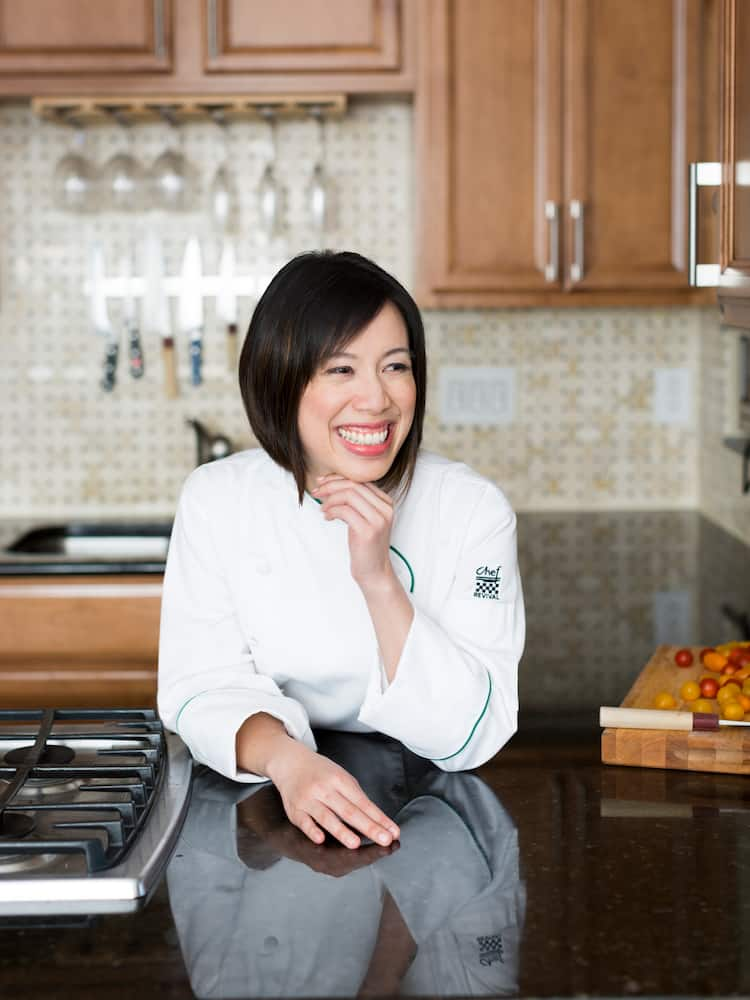
“Something I will be chasing for the rest of my life is to be able to re-create the dishes that my mom cooked to her level,” said Christine Ha, chef of two Houston restaurants.
She grew up with a protective mother who didn’t let her help much in the kitchen. She couldn’t go near the knives or the oven and only did “some small tasks like rolling egg rolls or mixing the filling for egg rolls,” the second-generation Vietnamese American said.
But when her mother died when she was 14, leaving no recipes behind, she missed the flavors that reminded her of her mother’s table and kitchen. During college, she set out to re-create her mother’s cooking by memory.
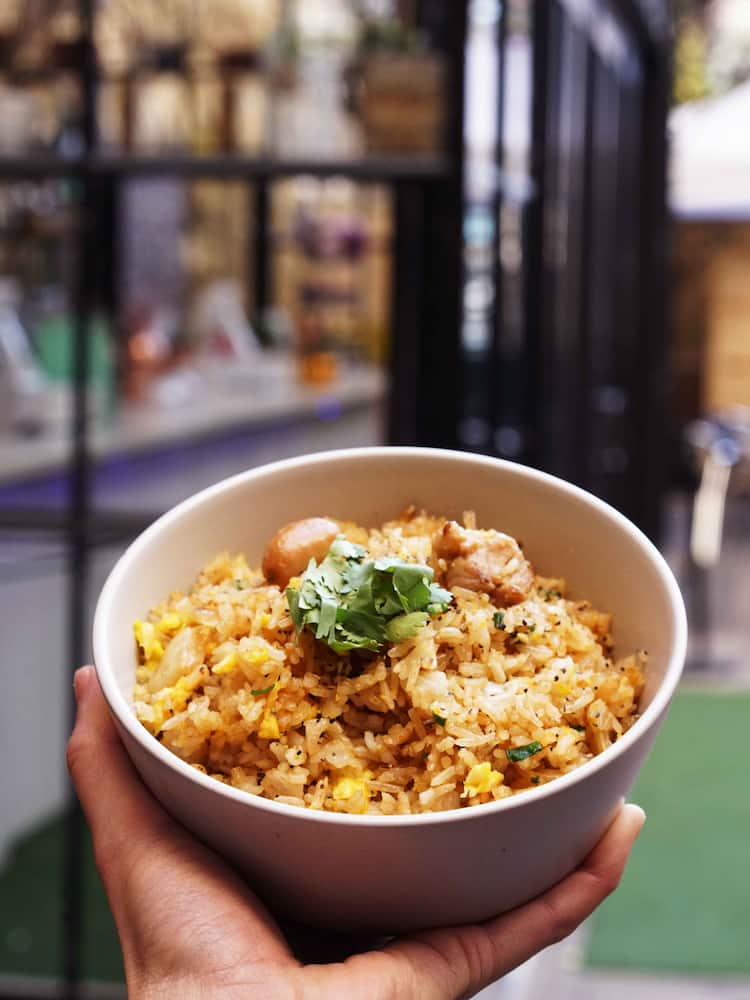
“I basically taught myself how to cook,” said Ha, who initially learned from cookbooks. “I would just kind of experiment in the kitchen and feed my friends and my roommates. … I got to a point where I was able to, once in a while, cook some dishes that my friends enjoyed. And there was something about being able to create food with my own two hands and make other people happy with what I’ve been able to create. That really sparked a joy in me for cooking, and that’s kind of where it began.”
Her comfort dish is fried rice, something her mom occasionally made “sauteing up some rice in a skillet, maybe with some Chinese sausage and egg and green onion.”
“Fried rice doesn’t sound that fancy at all, or very sexy, but that’s what I think of as comfort food for me,” said Ha, 41. “You can put anything in it so you can use up any leftovers. … It’s something I’ve grown up eating. It’s easy to eat. You can scoop it up in a spoon and in one bowl. And I love making fried rice, and I love eating fried rice.”
Ha made headlines as the first blind contestant on Fox’s “MasterChef” in 2012, a fact she embraces when she introduces herself, even naming her first restaurant The Blind Goat.
“As a Vietnamese American woman who eventually lost her vision, I’ve become used to that identity, and I’ve accepted who I am,” Ha said. “Being on ‘MasterChef’ and winning not only proved to other people, but I proved to myself that regardless of where I came from, if I worked hard at it and I didn’t let go of what my goals were, I could achieve them. I think that gave me more confidence to live the life that I live now. And I think part of it is also a joke about the saying, ‘When you can’t see something, you can’t fear it,’ so I always joke about how losing my vision helped me become fearless, but partially it is true because … I didn’t learn how to snowboard until after I lost my vision. I joke about how you can’t see how steep the mountain is, so then you can’t fear it. …
“There was a lot of freedom and liberation and being able to embrace who I am, disabilities and all. And I think that really just kind of gave me the confidence to do what I believe in. And I realized that when you strongly believe in what you do, whether it’s opening a business during a pandemic, cooking a certain type of food, living your life a certain way, if you strongly believe what you’re doing is right, then other people will also believe in it and will also follow you.”
This includes speaking up for her Asian American community. She hasn’t personally come across racist incidents, but her staff has.
“I feel vulnerable as an Asian American woman who also has a vision impairment, as a business owner. … I think many Asians, myself included, we were taught to kind of grow up being quiet and obedient and not really making a lot of noise and complaining a lot, and so I think it’s sometimes in our DNA to sort of turn the other way and accept things the way they are and just put our heads down and keep working and just try to make it on our own. But I think now’s the time where we really should be loud about what’s happening, because I really think that’s the only way to raise that awareness and to continue to have that conversation and make people aware of what is happening to the AAPI community. And I feel like people fear what they don’t know or don’t understand.
“And as long as we stay quiet, people will not get to know us and get to understand us as a culture and as a community. So in order to change that, I think we have to make the unknown familiar to everyone, and that means continuing to have this conversation, continuing to promote Asian-owned businesses, continuing to promote the culture and the food, and all of these other things that we do have that’s beautiful and in common with other people. Everyone has to eat. So I feel like food is definitely a good bridge … so that people can understand that underneath our skins we’re all the same. We’re all humans, we all bleed. We all have feelings.”
Martin Yan
TV cooking show host, cookbook author

Food is “the most powerful equalizer and diffuser against discrimination, against hatred,” said Martin Yan, an Asian American who appeared on television before celebrity chefs were commonplace.
This is why his comfort food is hot pot, a dish in which everyone can choose different ingredients to cook together in a soup. The host can join in on the meal and talk to everybody, instead of “slaving and sweating it out in the kitchen,” he says. It’s a staple in Asia, he adds, with different versions in Vietnam, Thailand, Korea, Japan and China.
Hot pot is also the perfect meal to eat together when everything is open again after the pandemic, Yan said.
The 72-year-old started on television at a time when the only other cooking shows were Graham Kerr’s “The Galloping Gourmet” and Julia Child’s “The French Chef.” His motto is “If Yan can cook, so can you!”
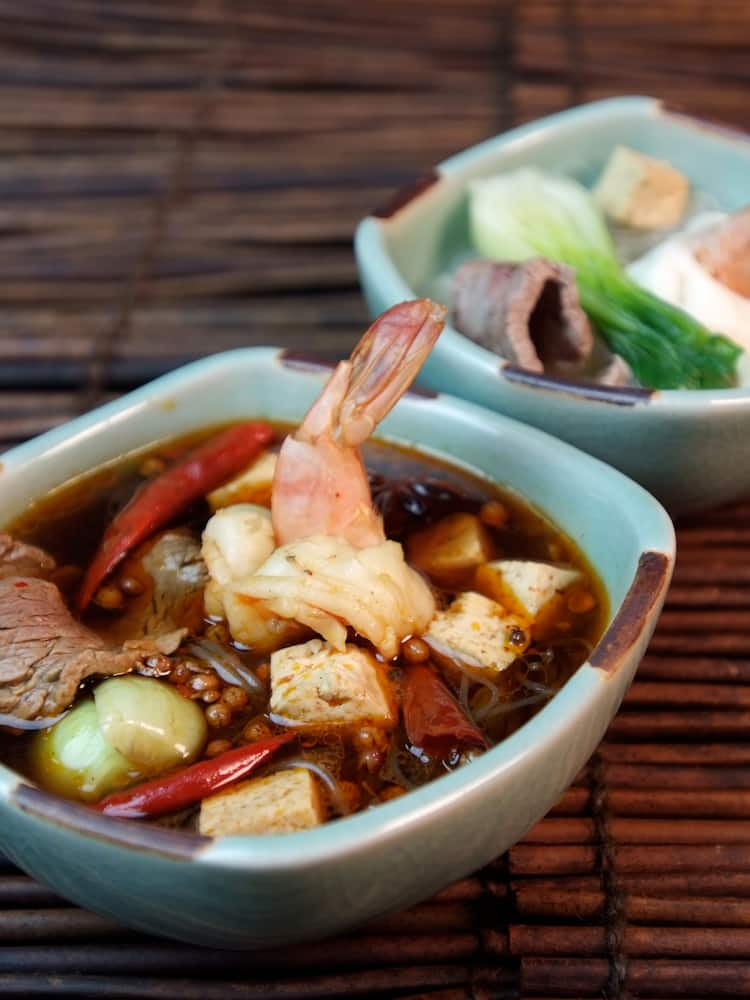
“When I was growing up, I was actually exposed to a lot of these ingredients — hoisin sauce, soy sauce, light soy sauce, dark soy sauce, vinegar, rice wine,” said Yan, who ran around his father’s restaurant trying different foods.
[Martin Yan’s Chicken and Asparagus Stir-Fry]
His father’s life wasn’t easy. In Portland, Ore., even after running a cafe and small jewelry store, he could not buy property as a Chinese immigrant, so he and the family returned to Guangzhou.
“There was a lot of discrimination,” said Yan, who is based in San Mateo, Calif. “In fact, they faced more problems than what we have been facing in the last 30, 40 years. They have no choice but … just made enough money and went back to China.”
He did not return to the United States until he attended the University of California at Davis on a church sponsorship and started teaching cooking classes.
“I consider myself as an ambassador, a culinary and cultural ambassador of East and the West,” said Yan, who teaches virtual classes during the pandemic. “I think all of us should learn to be inclusive, to accept each other, and to make this country a great country. … I hope all of us are using food as … a bridge.”
Niki Nakayama
Chef, restaurateur
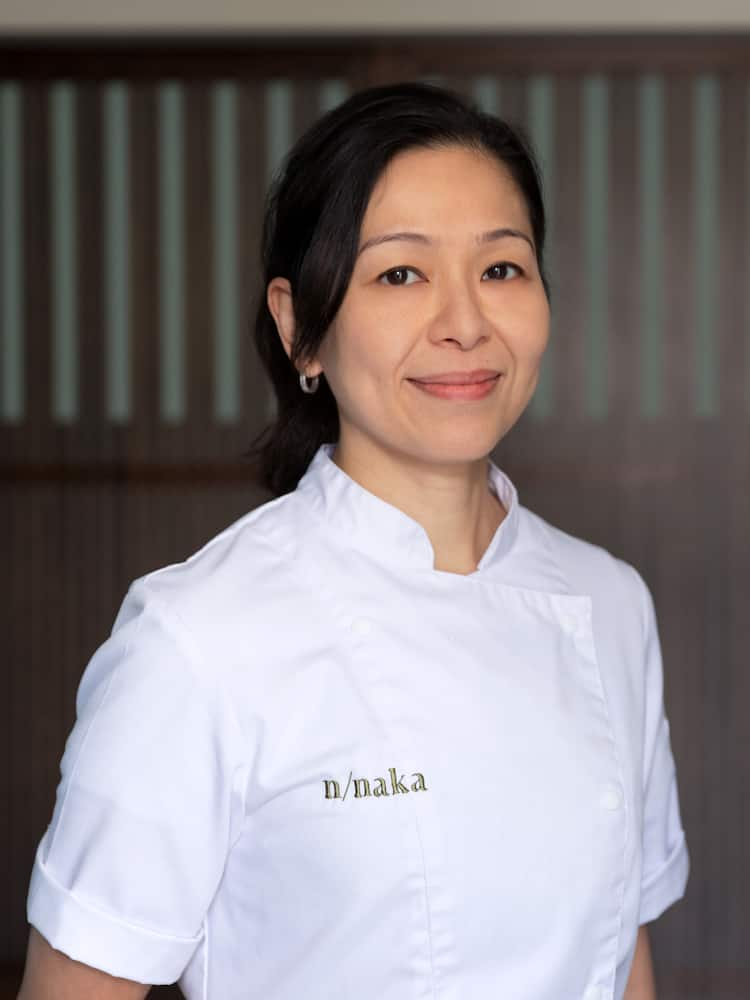
“I think my biggest comfort food is the one we always just end up eating at home,” said chef Niki Nakayama, who chose the Japanese hot pot dish shabu shabu as the comfort food she likes to share with her wife and sous-chef, Carole Iida-Nakayama. “I know this is so silly, but it’s just so every weekend when we’re at home, I always feel like I haven’t had enough vegetables throughout the whole week. So I always ask Carole and her mom if we could just eat shabu shabu. And then we just dump everything from the refrigerator in there and then we eat, but the most comforting part of the shabu shabu is when we’re finished eating all the vegetables and meat and everything, we dump in like a bowl of rice and mix it up so it turns into a porridge.”
The 46-year-old Japanese American was featured in the first season of Netflix’s “Chef’s Table” in 2015, about how she paved her way as a female chef in the patriarchal world of high-end cuisine. When she opened n/naka 10 years ago, she may have been the only female chef anywhere serving kaiseki (懐石), a traditional multicourse Japanese dinner that originated from a tea ceremony with roots in Zen Buddhism. In 2019, she earned two Michelin stars.
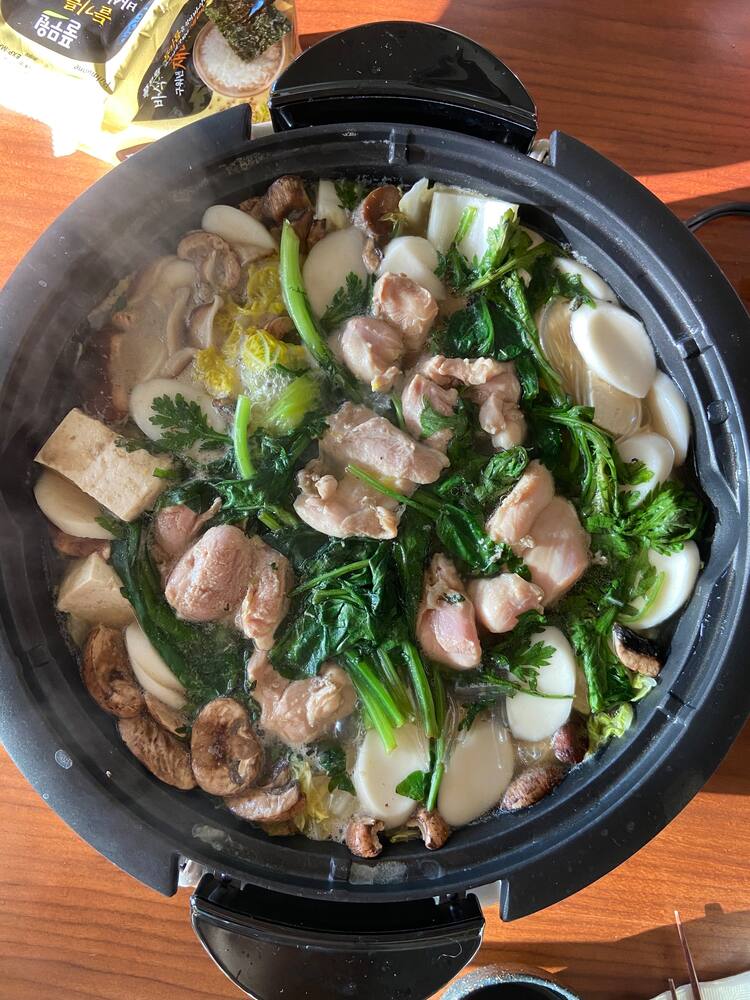
“When I first started out, it felt really hard to be taken seriously,” Nakayama said. “I think that the path that I’ve been able to take has been a really long road to get to where I am today. But I feel that for me personally, in spite of the struggles to be taken seriously and all those things, I think they were a really wonderful motivating factor to really ask myself if this was really what I wanted to do and stay on course. Because when you meet different obstacles along the way, there’s always a question of whether this is the right thing for you.”
Her latest challenge included opening a second restaurant during the pandemic, n/soto, which features bento boxes with collaborations. Among others, she has worked with Los Angeles’ Japanese American National Museum and supported the Little Tokyo Community Council, which provided other restaurants with grants during the pandemic.
The concept is based on the idea of “ekiben,” bento boxes sold at Japanese train stations that feature specialty ingredients and food of that station’s region. “So our goal is to use that concept to feature areas throughout L.A. or even like California to sort of collaborate … with other people to celebrate what’s important to them and hopefully getting to know and celebrate each other’s cultures or our differences.”
This was especially important to her during the pandemic, when so many businesses, including Asian restaurants, have closed. According to a 2020 study by the Center for Neighborhood Knowledge at the University of California at Los Angeles between February and April 2020, some 233,000 Asian small businesses closed due to the pandemic, a decline of 28 percent, compared to 17 percent of non-Hispanic White small businesses.
“When you’re in a bad place and when things around you aren’t doing good, the best thing that we felt was inspiring … was to do more good,” Nakayama said. “Let’s use food as a way to connect people instead of separating, because that’s what we are about.”
Hamza Khan
Aspiring pastry chef

When Hamza Khan hit a “random rough patch in life,” he needed to find something to get him through.
The 21-year-old came across his answer — baking — in the Netflix series “Chef’s Table,” watching episode after episode, getting hooked. He especially loved one episode that he felt spoke directly to him: When chef Ana Ros of Slovenia introduced a dish made with local marble trout, sea asparagus and anchovy water.
“She introduces the food, and she talks about how the land, the people and the food is all connected. And when she presented that dish, it was so beautiful. I started crying and I was like, I want to do this for the rest of my life,” said Khan, who was born in Virginia, raised in Pakistan and returned to Virginia to attend high school and community college. “That’s when I decided I want to do this. That was in 2019. And then I just started baking slowly. Then the pandemic hit and then I had a lot of time on my hands, so I’m just going to start learning more.”
“Just making desserts keeps me grounded,” Khan said.
His parents were understanding.
“When I told [my dad] I wanted to be a chef, he was like, ‘You know what you want to do? What you love to do is what you should do.’ So, he was very supportive. My mom was supportive, too, but they did want me to still get my bachelor’s degree. So I’m still currently doing that.” Now, he’s finishing his second year studying biology at Northern Virginia Community College.
It was his dad who pushed him to try YouTube to create tutorials. He was already on Instagram and “pictures just seemed like a really easy thing to do.” On Twitter, he found community among fellow Muslims and South Asians.
“You start to realize, oh, we’re not alone,” Khan said.
Besides testing recipes, he’s using social media to connect with other South Asian bakers, who advise him on how to perfect his skills, such as how to make croissants.
“People can connect through food,” he added. “I can showcase some parts of my culture that can maybe open conversations … but then I realized that … when a poet wants to do poetry or when an artist wants to do art, they have to be very skilled at what they’re doing to express themselves fully. … I want to fully understand and know how to bake. So when I do want to express parts of my culture as well, I can do it properly. …
“I wanted to see who I was and how I want to put that on the plate.”
After months and months of attempts at croissants, he put his own spin on them with pistachios, a common ingredient in South Asian and Arab cultures, he said.
His comfort food reminds him of where he was raised.
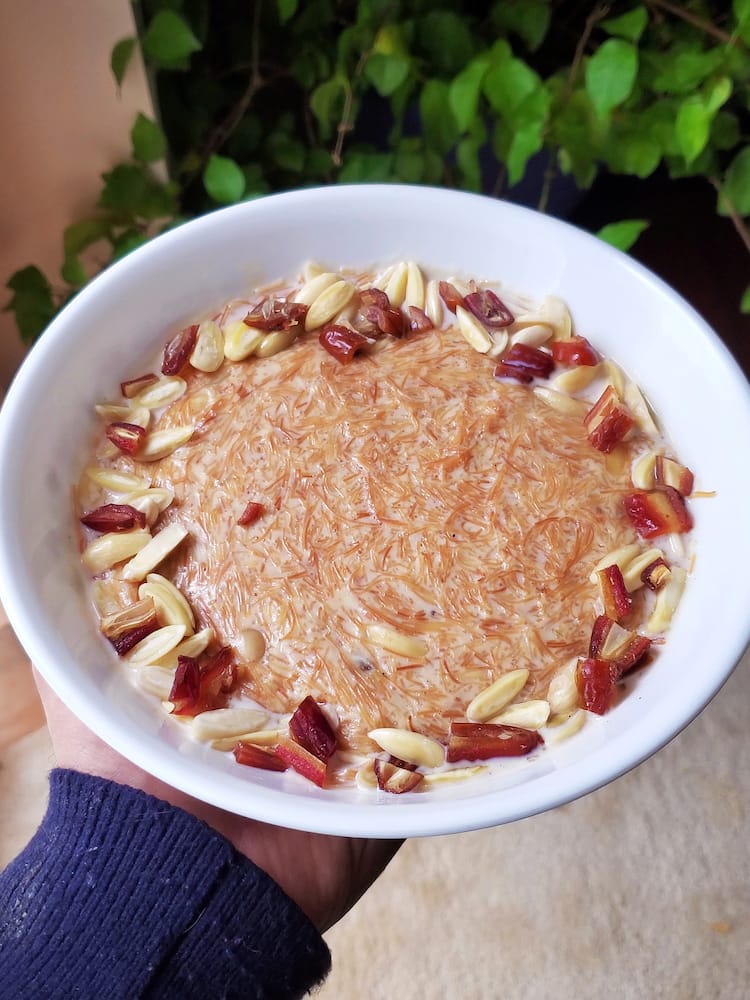
“Growing up in Pakistan, one thing that I loved a lot, and I still love it here, too, and it’s hard to find it in shops at the same level of just how good they were in Pakistan. But my mom does make them all at home,” Khan said. “It’s called seviyan. It’s like vermicelli and milk. … It’s just really simple, but it tastes amazing. And I’m lactose intolerant, but I still have a lot of it.”
After living in both Pakistan and the United States, he is not surprised by the recent attacks on Asian Americans.
“Muslims have faced a lot of hate for decades by now already, so it wasn’t something new for us, for me personally. But it was definitely sad to see how the previous [U.S.] government, with the hate that they spent regarding other groups, the result of that is coming to fruition,” Khan said. “There are stories like my grandma, she was just walking me outside one time. This is around the time, like post 9/11, and some guy in a truck pulled down his window and spat on her. … But to see other groups have to go through the same thing is definitely really painful. And … because we have gone through pain in the past, it’s something that I feel like we need to make sure that we address and make sure that we’re there for support.”
Grace Young
Food writer, cookbook author
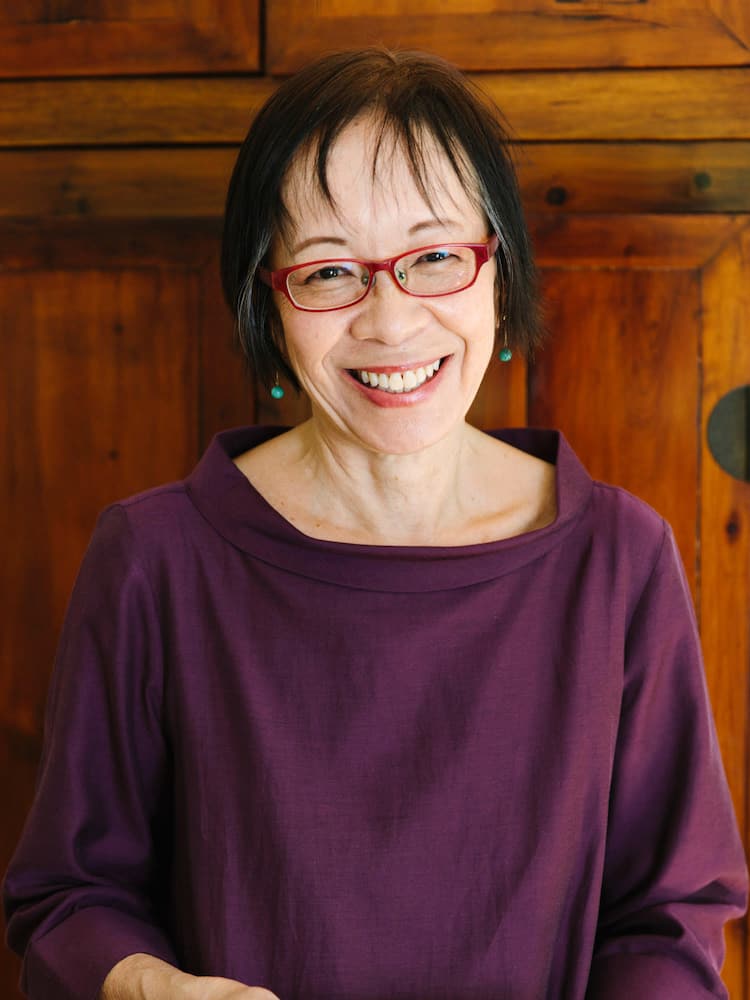
“I think the smartest thing I ever did in my life was taking the time to go home and learn my family’s recipes,” said Grace Young, a food writer in her 60s who has worked in food development and styling since her 20s.
“I think lots of people think back when they first came, got out of college, they should have bought real estate. Can you imagine if you had bought a little apartment or a house somewhere? Like, it would be worth so much money now,” said Young, who flew back to San Francisco in her 30s to learn her family’s recipes that she had “taken for granted.” “But I think I have something even more valuable, and that is that I took the time to learn my family’s recipes and now my mom, my grandmother, my father, so many relatives have passed away or they’re so old that they no longer cook.”
At first, her parents, then in their 70s and 80s, were hesitant to teach her, because they were not professional cooks.
But “they were obsessed with food and freshness and they are self-taught cooks, and we had the most extraordinary meals every single night. My father was a liquor salesman, so most of his accounts were in Chinatown, so he was always in Chinatown every day. … All the store owners knew him. So it was the original farm-to-table.”
[Five basic rules for woks from Grace Young]
In talking to her parents about how to cook, she was able to ask more about their own histories. Young’s father was born in San Francisco’s Chinatown, left for Guangzhou, China, and returned in his 20s, while her mother was born in Hong Kong and raised in Shanghai.
“They were always very reluctant to talk about their past because they left China for a better life in America. And so, when I would ask them things about China, they never really wanted to talk. But because we were talking about food and cooking, it was sort of an easy way for them to talk about their past and their memories that wasn’t threatening.”
So naturally, Young’s comfort food, wok-seared bok choy with shiitake mushrooms, goes back to her family.
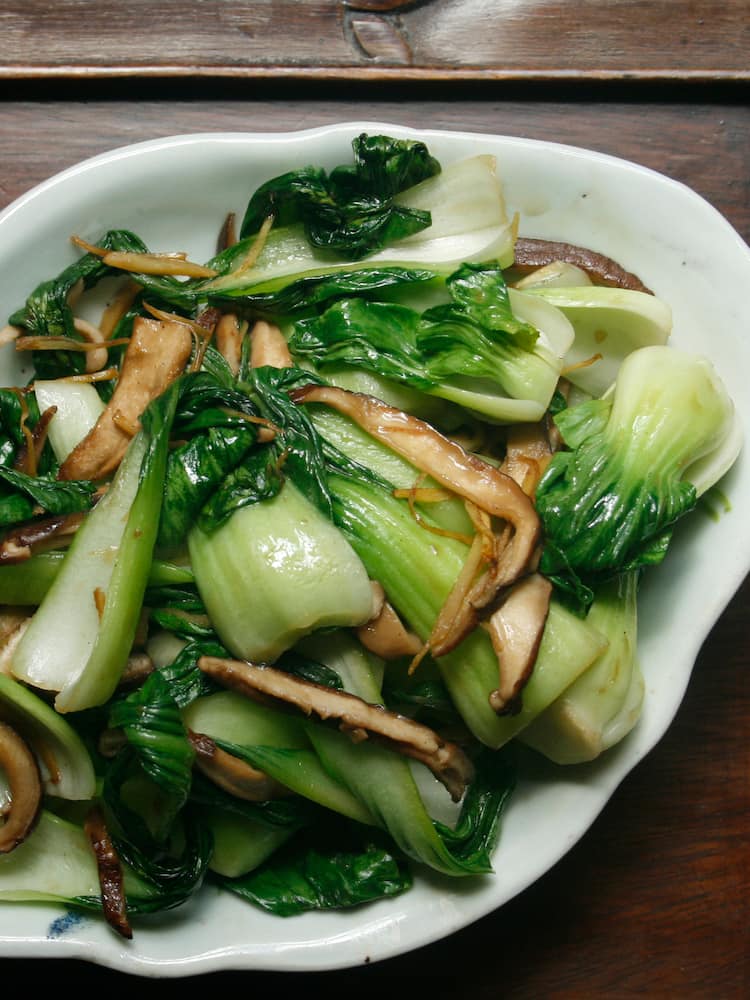
“It really reminds me of the appreciation my parents gave me for a great stir fry,” said Young, whose acclaimed books include “The Breath of a Wok” and “Stir-Frying to the Sky’s Edge.” “It’s also doubly comforting during covid because of the health benefits. Mushrooms are reputed to be very good for building your immune system. … and bok choy is high in beta carotene and vitamin C, folate, iron. So, when you grow up Chinese, your parents are always telling you not only is something delicious but what the health benefits are. … And I love something that just tastes so fresh. There’s a purity about it that is so wonderful.”
Like her father, she also frequently visited Chinatown for food and noticed when Chinatown in Manhattan was becoming deserted last year because of the pandemic.
[Asian American businesses are defending themselves against rise in anti-Asian violence]
“I’m in Chinatown quite a bit … to shop, to buy food, and I immediately noticed that something was really wrong,” said Young. “I couldn’t really pinpoint what was happening because at that point there were no covid deaths in the United States. But Chinatown had already emptied out and it was a ghost town. … I will always remember the looks on the faces of the chefs and the dishwashers and the prep cooks and the waiters. Everyone knew that this was something that was in the air. And you could feel the ominous sadness and the heaviness of what was happening.”
She ended up documenting “the last day Chinatown was Chinatown” on March 15, producing an oral history with videographer Dan Ahn on how Manhattan’s Chinatown was impacted by the pandemic.
“We’ve lost legacy restaurants and shops that have been a part of Chinatown. They’re not just places to eat and shop, but they hold your memories and they were pillars of the community,” Young said.
[Tips for successful stir-frying from Grace Young]
She also partnered with the James Beard Foundation to help support Chinese restaurants through an Instagram campaign, and worked with Asian Americans for Equality to raise money for personal security alarms for Chinatown seniors, restaurant workers and business owners.
“I have never felt unsafe in America,” said Young, who carries a personal safety alarm. “I’ve never felt unsafe in New York, and now when I walk on the streets, I feel that I need to be really alert and I need to be paying attention to everything that’s going on around me‚” Young said. “When I’m in Chinatown and I see someone elderly out walking … I worry whether or not … they’ll make it home safely. And it’s a really sad feeling to be Asian American and to think I look at my favorite shops and restaurants and stores and I think, ‘Are they safe? Are they going to be okay?’”
Jo Koy
Comedian, author, “Mixed Plate”

“My whole life, I felt like I was the ambassador for Filipino food and culture,” said Los Angeles comedian Jo Koy. “I used to always have to brag about the food that we ate, and I always try to convince people to come over and try my mom’s food. So it’s always been a part of my life. And every time I have an opportunity to celebrate my culture, show people our food, I always take advantage of it.”
So when it came time to name his new book, Koy of course thought of food and dubbed it “Mixed Plate.”
“I just think it’s a beautiful way of looking at life for me,” said Koy, who is White and Filipino. “You look on that plate and it’s just a bunch of different ethnicities being represented on that plate individually. They’re delicious. So you put them all on the plate at the same time, and it’s just that much more good.”
His book dives into how he grew up and became a comedian, but also how to make the food he grew up with, from lumpia to pancit. It includes a recipe for one of his favorites, chicken adobo, his comfort food now.
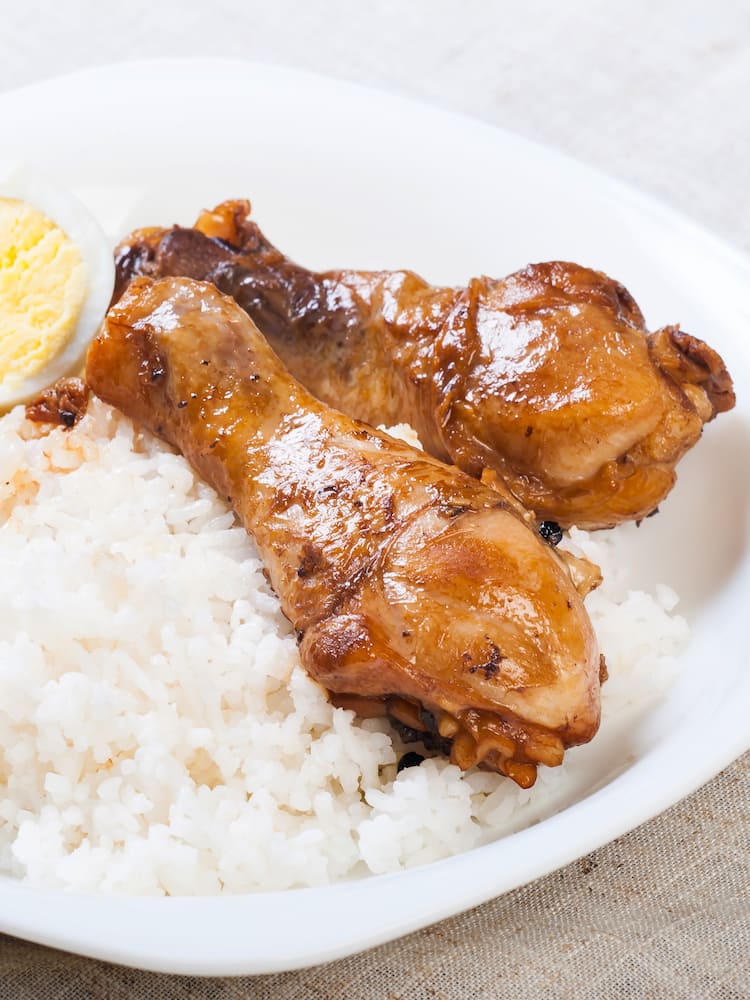
“That’s our signature to this day,” said Koy, who is in Vancouver shooting a film produced by Steven Spielberg about his family, called “Easter Sunday.” “I still remember the flavor that popped off in my mouth. I was like, ‘Oh my God, what is this?’…
“Who would have thought soy sauce and vinegar and garlic would do such damage? And it’s just amazing how it just pops off in your mouth. … It’s that delicious. So, it upsets me that it’s not mainstream yet, like it should be like the No. 1 thing right now. Everyone should try it, because once you try it, you fall in love with it. It’s a no-brainer.”
But growing up he found that his family’s food was not always easy to introduce to schoolmates, especially when his mom used a Cool Whip container to pack Filipino food for school lunches.
“The older you get, you start telling your stories. You start realizing that you weren’t alone,” said Koy, whose full name is Joseph Glenn Herbert.
“My goal was always to talk about my culture. I always wanted to indirectly let people know I was Filipino by telling the stories from my mom. I’m not representing all the Asians … I’m representing my culture and representing my mom and getting … that awareness out there, because it makes people go, ‘Oh, wow, we’re just like that.’ … Maybe it just takes … a lot more of those stories and we’ll start to see more people relating more and understanding and appreciating.”
In the process of telling these stories and writing them down, Koy realized that racism and discrimination had been a part of his life; for example, “ethnic shows,” like “Wonton Wednesdays,” were the only way many minority comedians could get their start.
“I was accepting it, and a lot of Asians were accepting it, because that’s just how you felt in this country. And, you know, the stories about my mom, where I just I felt so bad for her, where I’m just like, here she is, an American citizen, but yet she’s feeling like she’s a guest and she should keep her opinions to herself and not really use her voice in certain situations, and it’s just a horrible way to live. And, now we live in a time where that’s not going to happen anymore.”
Jiyeon Lee
Chef, restaurateur
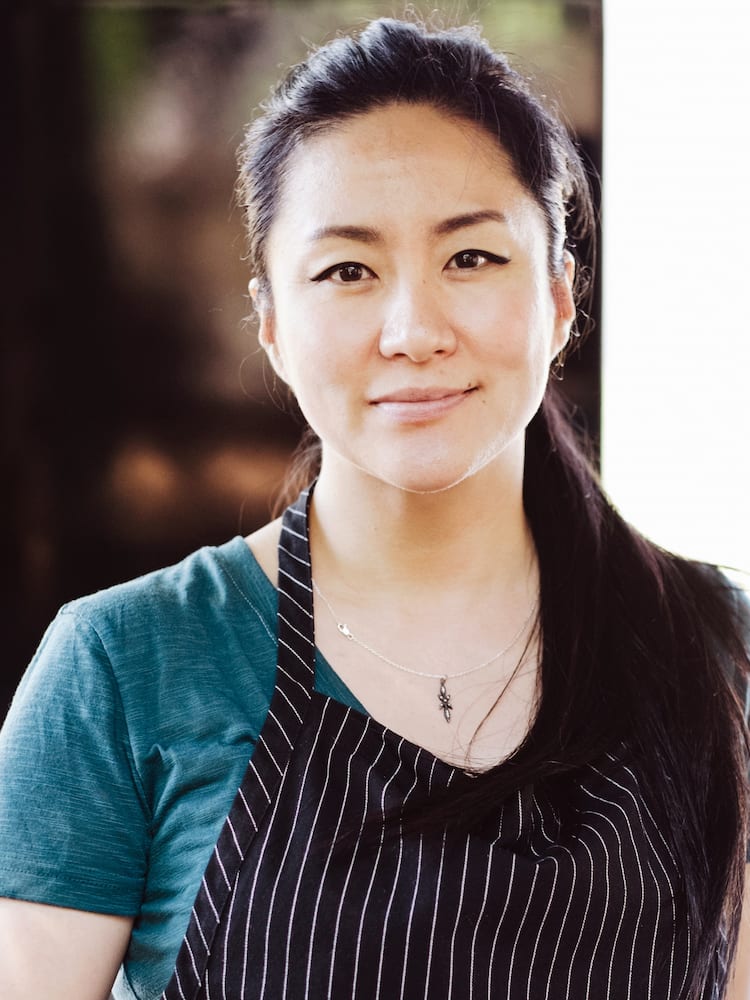
When Jiyeon Lee thinks of comfort food, she remembers cooking with her mother and grandmother in the South Korean countryside.
“I think most of Asian culture, when your mom or grandma is cooking, we help them,” said Lee, 50. “My grandmother raised me because my mom and dad were trying to settle in the big city.” Her parents left their children with her grandmother “and slowly brought them to the city, and I was the last one they brought. …
“We barely could have Korean barbecue. … We couldn’t afford those things back then, so my grandmother always made the broth with dried anchovy, dashima [dried kelp or 다시마] … and some radishes, onions …

“Flour was the cheapest ingredient back then, so my grandmother always made a little dough and hand-pulled dumplings,” Lee said. “I make it very often. It’s pretty easy to make and such a comfort food for me with a good memory of my grandmother.”
She runs Heirloom Market BBQ in Atlanta with her husband, Cody Taylor, both named semifinalists for Best Chef: Southeast in 2020 by the James Beard Foundation. They serve Southern barbecue with some Korean flourishes, such as spicy Korean pork, kimchi slaw and sweet-and-spicy tofu.
It’s her third restaurant, after two failed attempts with a sushi spot and a cafeteria inside an office building. But this is also her second career, after immigrating to America at 28, and after shooting to fame as a pop star.
“I used to be a singer and model in Korea when I was a teen. I have four albums, pretty successful in my previous career, but I wasn’t really happy … because I was too young, because I was in high school and just became like an overnight Cinderella-kind of story. … I love to be on a stage, but it was very difficult … for a young little girl handling that kind of pressure,” Lee said. “I wanted to change my career … I wanted to change my lifestyle and environment.”
This led to restaurants in America, and the “little butterflies” returned like at the beginning of her singing career.
Her restaurant has now been open for a decade. Referring to the March killing of eight people, including six women of Asian descent, at three spas, she said: “That tragedy that happened in Atlanta, it was such a shock to the Asian community.”
“I’ve lived in Atlanta for 21 years, but I never really feel racism toward Asians. … Ignorance, yes … but not violence,” she said.
Still, to be on the safe side, she says, she carries pepper spray when she walks her dog at night.
“I’ve been lucky since I was little. I grew up in a very poor family, but I had a big chance to be a model and singer. … I still feel like I’m in a very lucky spot. … Some of the less fortunate people are out there in a very dangerous environment. You’ve got to raise a voice for them.”
Preeti Mistry
Chef, podcast host, food activist
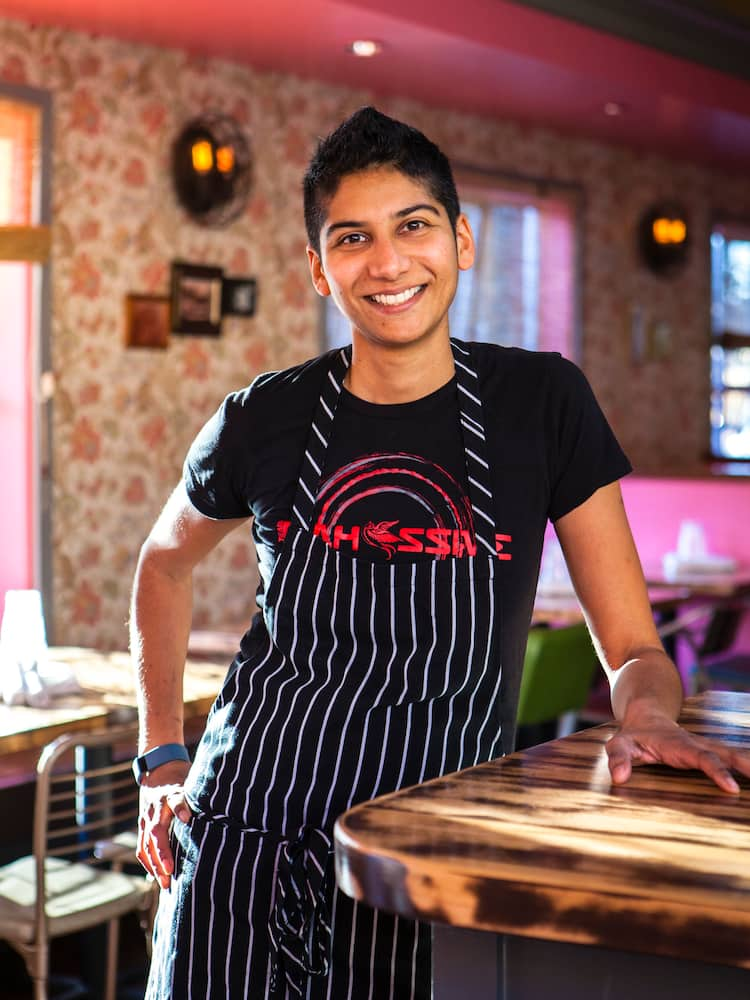
Preeti Mistry does not shy away from speaking out.
Before the racial reckoning came down hard on the food industry, singling out such institutions as Bon Appétit, the chef was vocal about issues of inclusion and identity.
“It’s time to give credit where it’s due,” Mistry said. “The fact remains in our country that politics, media, land ownership, power are not reflective of our actual diverse society. I think it’s important to continue pushing the needle to create a more inclusive world that reflects the true talents of many diverse voices.”
The chef stirred controversy for saying in a 2017 New York Times profile of French Laundry chef Thomas Keller that “haute couture appropriates from minorities and urban communities” and that “chefs as powerful as Mr. Keller have a responsibility to address those issues and “need to go on a woke journey.”
While many in the industry came down on Mistry for the comment, Nick Cho swooped in as their “guardian angel” to become their friend on Twitter. Cho, known as “Your Korean Dad” on TikTok for his wholesome takes on life, is one of the subjects of their new podcast, “Loading Dock Talks.”
The podcast captures the camaraderie of chefs when they get together when cooking at events. It includes many of Mistry’s “favorite food folks” discussing such topics as queer intelligence and the immigrant experience.
“We need more diverse voices on both sides of the interview,” said Mistry, 44. Conversations that are between two Black, Indigenous or people of color, or particularly between two Asian Americans, the chef said, “are inherently different in their dynamic.”
“When White people are the gatekeepers, their choices are coming from that perspective, even when they are trying to do more to highlight diverse voices. … It’s sort of like Hollywood movies. We have had enough straight White love stories.”
In the episode featuring Cho, the two reminisced about how their immigrant parents assimilated.
“I’m very cognizant of the fact that they don’t have the choices that I have,” said Mistry in the podcast, referring to their Indian parents. “And the reason I’m able to be outspoken and be gender nonconforming and be a chef and a woman period is because they did that thing of just keeping their nose to the grindstone and their heads down and not complaining or anything so that, you know, people like me and you can pop off about whatever we see.”
Mistry’s chosen comfort food, dumplings, also reflect the intersection of food and identity. They recently were part of a dumpling fundraising campaign connecting Asian food makers to support Black farmers. It included dumpling tutorials and conversations with other food movers and shakers.
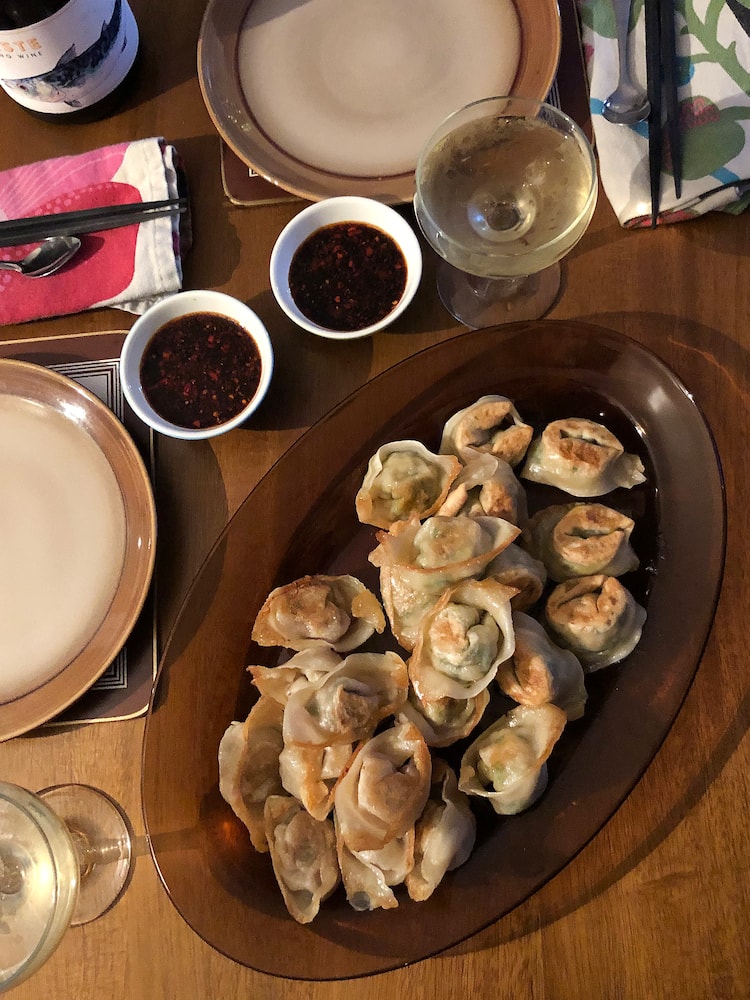
“The idea was sort of like us virtually sitting around the table folding dumplings, but also having a conversation about race and identity,” said Mistry, who made a lot of dumplings during the pandemic, including ones stuffed with duck and shrimp with wrappers made from scratch. “I think it is always important to recognize and acknowledge the anti-Black racism in a lot of our Asian American communities. And to then move towards reconciling those issues with finding solidarity, because the ultimate goal of white supremacy is to pit us against each other and not recognize white supremacy as the evil that negatively affects all of our communities.”
Mistry’s food chops are extensive; they ran kitchens at San Francisco’s deYoung Museum and Google headquarters. Their now-closed Oakland Indian street food-inspired restaurant Juhu Beach Club was featured on Anthony Bourdain’s CNN show “Parts Unknown.” They also appear in the Netflix children’s show about food, “Waffles + Mochi,” starring Michelle Obama.
Before the pandemic started, Mistry bought a cabin with their wife and business partner, Ann Nadeau, in Sonoma County. Mistry was working on a farm and now volunteers for Farm to Pantry, which gleans excess produce from large farms and donates it to food pantries, and recently joined the board. “Not only are you feeding people directly, but it’s keeping that methane gas out of the environment, because if that food doesn’t get eaten or used, it ends up in a landfill. … I felt like it was important to just do my part.”
Nong Poonsukwattana
Chef, restaurateur, podcast host
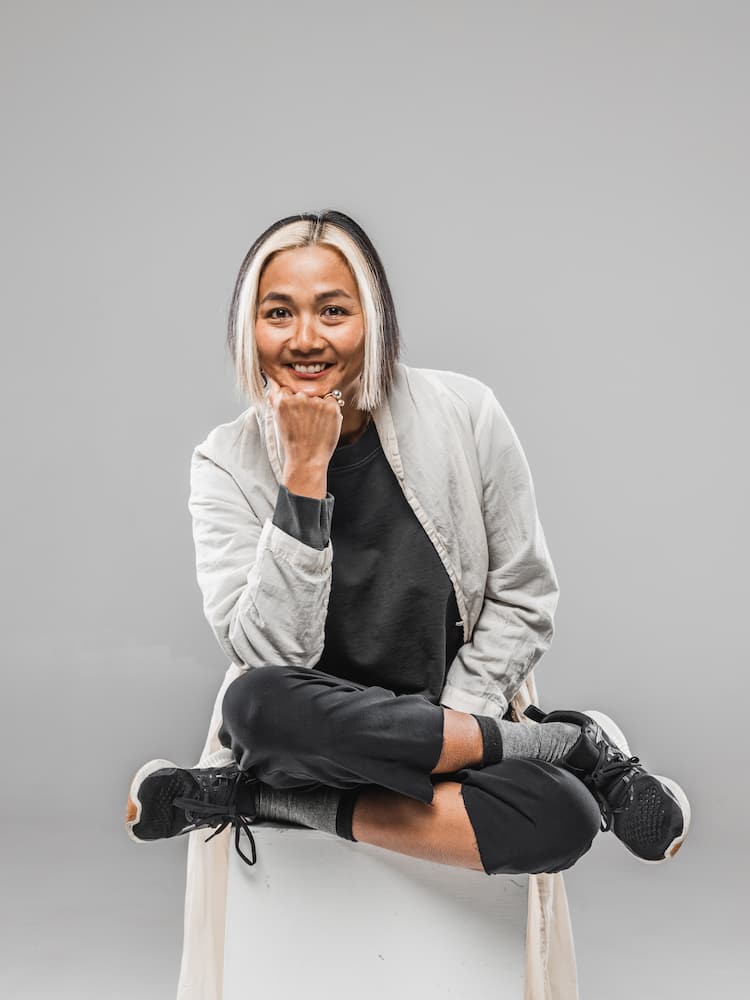
Being a restaurateur during the pandemic has been like getting thrown overboard in the middle of the ocean and hanging for dear life on a board, said Nong Poonsukwattana, who had to shut down one of her two restaurants in Portland last March.
“I can have my family on my board, but I can have some room on the board and I can put some people on this board and swim and plow through this storm and then we are still in the middle of the ocean. But you know that there will be some people that … might never come back. …
“I lost about like 45 percent of my team,” said Poonsukwattana, who started a podcast called “Riding Tiger” aimed at helping entrepreneurs to learn and grow their businesses. “I think that it is important that I have to have a desire to fight for my business, for my team, for my family, because this drive, I can do my part and help my staff and help the economy.”
Her comfort food is what her mom gave her to recover during tough times, a dish known at her restaurant as “Super Soup.”
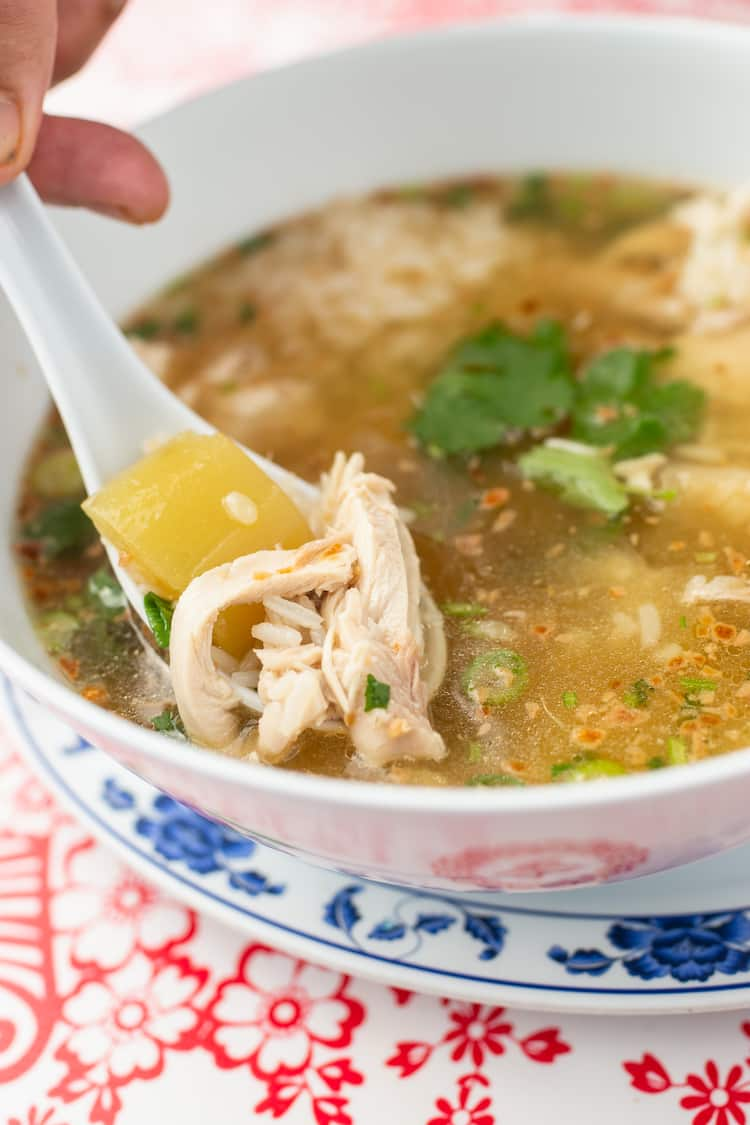
“I think every Thai mom or Asian mom will make rice soup or jook for their kid when they’re sick,” said Poonsukwattana, 41, referring to rice porridge. “The broth has all the bones and all the vegetables, and the protein is either pork or chicken, and it’s easy to digest. And it helps the body to recover.”
Her drive has kept her afloat despite the circumstances. In 2003, she immigrated from Thailand with only two suitcases and $70. She worked in restaurants, saving up to buy a kettle corn trailer to house her first food cart in 2009. She started serving one main dish — chicken and rice or khao man gai (ข้าวมันไก่) — then expanded to restaurants in 2011.
But it’s been a tough road for Poonsukwattana, who won an episode of the Food Network’s “Chopped” in 2014 and was named a James Beard semifinalist for Best Chef: Northwest in 2019. She says she gets treated differently due to her accent at such places as 7-Eleven.
“It is not like Thailand, where we were taught to welcome foreigners. We look at foreigners as better than us,” she said. “If you just come from America, we want to be like you, you’re above us.”
But she hopes that food will be that “good example of how we do business … We are trustworthy. We are good. We share food and we also share the way we do business and treat people the right way.”
Sheldon Simeon
Chef, restaurateur, cookbook author

“I was destined to become a chef because I come from a family of amazing cooks,” said Sheldon Simeon, who rose from Walt Disney World busboy and prep cook to celebrated restaurateur and cookbook author. “My whole childhood and the best memories are me surrounded by family gatherings, of us cooking in the garage and cooking with aunts and uncles and cousins and having a feast. As we sit down and eat, we’re talking about what we’re going to have for our next meal.”
His family spent the last three generations in Hawaii, with his grandparents immigrating from the Philippines as teenagers. So when he thinks of food, it’s “always through the lens of Hawaii and Filipino.”
“So when I discover and taste new things, my mind instantly thinks of, ‘Oh, this is kind of like this Filipino dish. This is kind of like this Hawaiian dish,’ ” said Simeon, who was a “Top Chef” finalist in Season 10 and 14, winning Fan Favorite both times. “I try to cook the food … we grew up eating and let that be the biggest influence and what I want to make.”
Hawaiian food is “not the mangoes and seaweed salads that you see,” added Simeon, referring to the proliferation of Hawaiian poke shops nationwide. “Hawaiian food has two tiers. Hawaiian food being that of the Indigenous people, the core Hawaiians that made Hawaii their home. If you see kalua pig, that was the pig that was cooked underneath the ground in an imu [underground oven], that is the Indigenous culture. … And then the second tier is all the influences by the migrants here, and a lot of it is Asian, Japanese, Korean, Filipino. But we also have Portuguese and Puerto Rican and other cultural influences. So that’s Hawaiian food in a snapshot.”
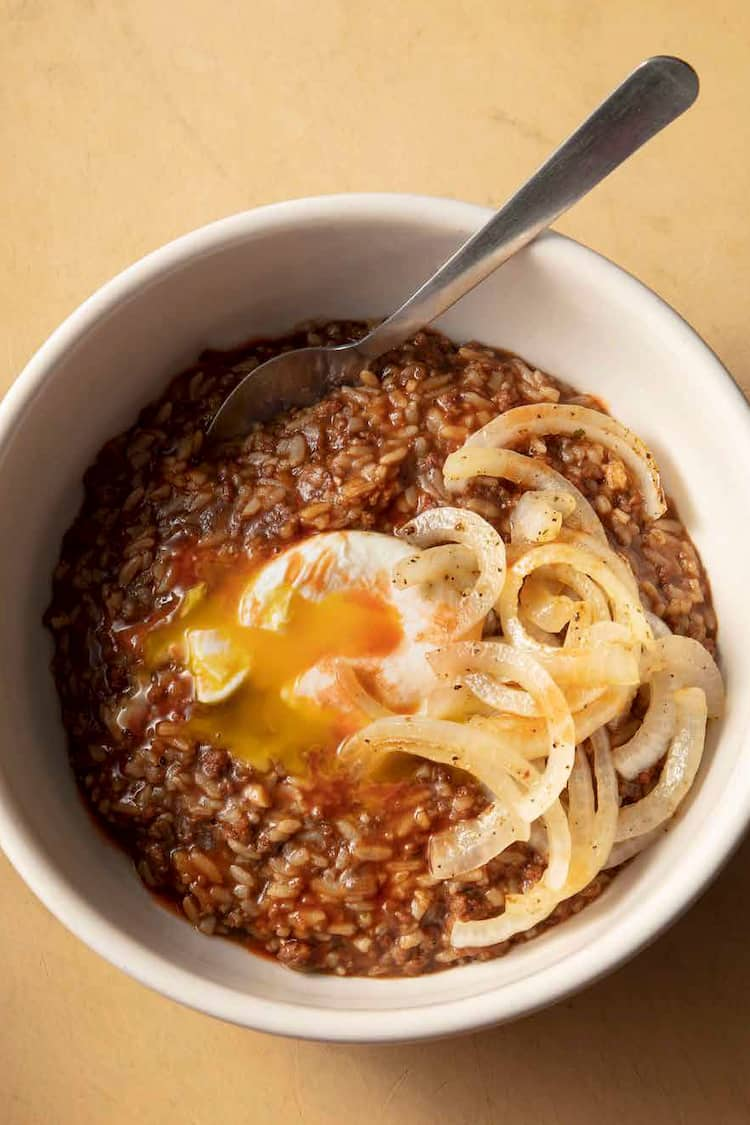
That’s also why for his comfort food pick is loco moco, “the most American” dish with ingredients “you could find in a diner and anywhere across whatever the Midwest, but it’s distinguishably Hawaii and that’s what Hawaii food is,” said Simeon, who owns the restaurant Tin Roof in Maui.
It includes a “perfect hamburger patty, a fried egg and gravy all over,” on top of a bed of Simeon’s favorite ingredient.
“I could never go a day without rice,” said Simeon, 39, who laughs at the thought. “I love rice beyond anything.”
Like its food, Hawaii itself is often misunderstood.
“Don’t go … treating Hawaii as your amusement park. Seek out its history, seek out its people, because it’s a lot more beautiful than just what you see on the surface beyond the palm trees and the sunsets,” Sheldon said. “I’m very fortunate for living in Hawaii, where there is diversity played out throughout and that’s normal … But it just makes me want to tell our story. … As Asians here in America … our story is just as layered and just as beautiful as everyone else’s. And I think Hawaii can be a great snapshot for what this country needs of us, respecting each other’s culture and celebrating each other.”






